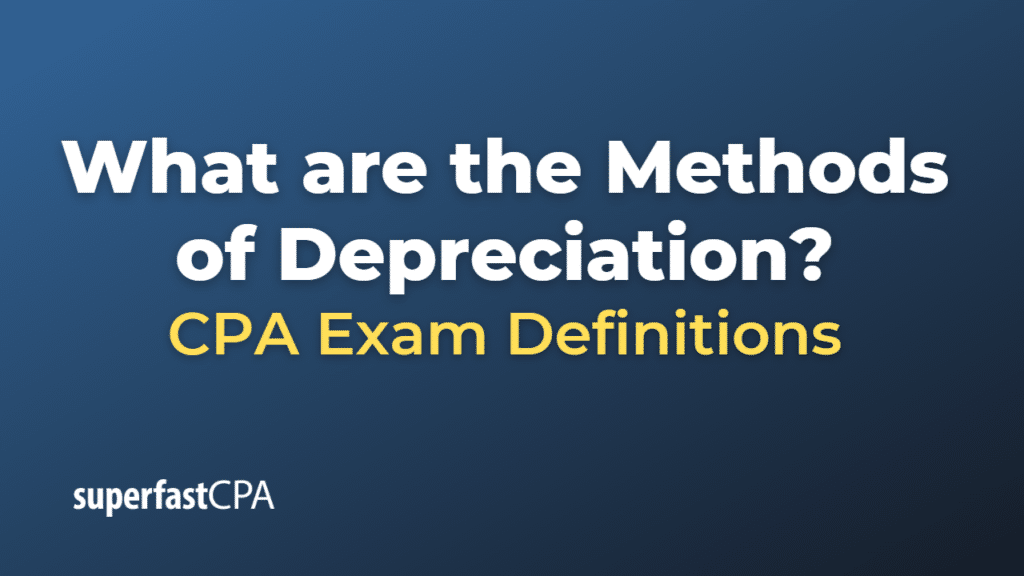Methods of Depreciation
Depreciation is used to spread the cost of an asset over its useful life. There are several methods of depreciation, and the appropriate method to use can depend on both the nature of the asset and the company’s specific circumstances. Here are some of the most common methods:
- Straight-Line Method: This is the simplest and most commonly used method. It spreads the cost of the asset evenly over its useful life. The formula is (Cost of Asset – Salvage Value) / Useful Life. The salvage value is what the company expects to sell the asset for at the end of its useful life.
- Declining Balance Method: This method results in higher depreciation expenses in the earlier years of an asset’s life and lower expenses in the later years. It’s often used for assets that lose value quickly early on. The most common version of this method is the Double Declining Balance (DDB) method. The DDB rate is simply twice the straight-line rate. Importantly, the salvage value is not considered in the depreciation calculation, but depreciation stops once the book value equals the salvage value.
- Units of Production Method: This method bases the depreciation expense on the actual usage or production of the asset, rather than the passage of time. It’s particularly useful for assets whose wear and tear is more closely linked to the volume of output, like manufacturing machinery. The formula is (Cost of Asset – Salvage Value) / Useful Life in Units * Units Produced in the Period.
- Sum of the Years’ Digits Method: This is an accelerated method like declining balance but uses a different formula to calculate depreciation. It involves adding up the digits for each year of the asset’s life. For a 5-year life, that would be 5 + 4 + 3 + 2 + 1 = 15. In the first year, 5/15 of the depreciable base would be depreciated, in the second year 4/15, and so on.
Different methods may be appropriate in different circumstances. The straight-line method is straightforward and simple, but the declining balance method might be better for assets that lose value rapidly, and the units of production method might be more suitable for assets that wear out with use rather than with time. The choice of method can significantly impact a company’s financial statements and tax liability.
Example of Methods of Depreciation
Let’s take the example of a company that buys a machine for $100,000. The machine has an estimated useful life of 5 years and a salvage value of $10,000 at the end of those 5 years. Let’s calculate the annual depreciation using different methods:
- Straight-Line Method
Annual Depreciation = (Cost of Asset – Salvage Value) / Useful Life
= ($100,000 – $10,000) / 5
= $18,000
So the company would depreciate $18,000 of the machine’s value each year for 5 years. - Double Declining Balance Method
In the first year, the depreciation rate for the straight-line method would be 1 / 5 = 20%. So the double declining balance rate would be 20% * 2 = 40%.
For the first year:
Depreciation = Book value at the beginning of the year * DDB rate
= $100,000 * 40%
= $40,000
For the second year, the book value of the machine at the beginning of the year would be $100,000 – $40,000 = $60,000.
Depreciation = $60,000 * 40% = $24,000
This continues, but remember, with DDB, we do not depreciate below the salvage value. So the last year’s depreciation might be less than the calculated 40% to ensure the book value doesn’t fall below $10,000. - Units of Production Method
Let’s assume the machine will produce 50,000 units over its useful life. The depreciation per unit would be ($100,000 – $10,000) / 50,000 = $1.80 per unit.
If in the first year, the machine produces 12,000 units, the depreciation would be $1.80 * 12,000 = $21,600.
If in the second year, it produces 10,000 units, the depreciation would be $1.80 * 10,000 = $18,000, and so on. - Sum of the Years’ Digits Method
The sum of the digits for a 5-year life is 5 + 4 + 3 + 2 + 1 = 15.
In the first year, the depreciation fraction is 5/15, so the depreciation would be ($100,000 – $10,000) * 5/15 = $30,000.
In the second year, the depreciation fraction is 4/15, so the depreciation would be ($100,000 – $10,000) * 4/15 = $24,000, and so on.
These examples show how different methods can lead to very different depreciation expenses, especially in the early years of an asset’s life. These differences can have a significant impact on a company’s financial statements and tax liability.












